WISE 0855−0714
 Time-lapsed photo sequence of WISE 0855−0714's movement in the sky using captured images from the WISE and the Spitzer telescopes.[1] | |
| Observation data Epoch J2000 Equinox J2000 | |
|---|---|
| Constellation | Hydra |
| Right ascension | 08h 55m 10.83168s[2] |
| Declination | −07° 14′ 42.5256″[2] |
| Characteristics | |
| Evolutionary stage | Sub-brown dwarf |
| Spectral type | Y4V[3][4] |
| Apparent magnitude (J) | 25.00±0.53[2] |
| Apparent magnitude (H) | 23.83±0.24[2] |
| Astrometry | |
| Proper motion (μ) | RA: −8,123.7±1.3 mas/yr[3] Dec.: 673.2±1.3 mas/yr[3] |
| Parallax (π) | 439.0 ± 2.4 mas[3] |
| Distance | 7.43 ± 0.04 ly (2.28 ± 0.01 pc) |
| Details | |
| Mass | ~3–10 MJup |
| Temperature | 250±50[3] K |
| Other designations | |
| Database references | |
| SIMBAD | data |
Location of WISE 0855−0714 in the constellation Hydra | |
WISE 0855−0714 (full designation WISE J085510.83−071442.5,[6] or W0855 for short) is a sub-brown dwarf 2.28±0.01 parsecs (7.43±0.04 light-years)[3] from Earth, therefore the fourth-closest star or (sub-) brown dwarf system to the Sun,[1] the discovery of which was announced in April 2014 by Kevin Luhman using data from the Wide-field Infrared Survey Explorer (WISE).[1] As of 2014[update], WISE 0855−0714 has the third-highest proper motion (8,151.6±1.8 mas/yr)[3] after Barnard's Star (10,300 mas/yr) and Kapteyn's Star (8,600 mas/yr)[6] and the fourth-largest parallax (439.0±2.4 mas)[3] of any known star or brown dwarf. It is also the coldest object of its type found in interstellar space, having a temperature in the range 225 to 260 K (−48 to −13 °C; −55 to 8 °F).[1]
Characterization
Observations
The WISE object was detected in March 2013, and follow-up observations were taken by the Spitzer Space Telescope and the Gemini North telescope.[1]
Distance
Based on direct observations, WISE 0855−0714 has a large parallax, which specifically relates to its distance from the Solar System. This phenomenon results in a distance of around 7.43±0.04 light-years,[3] with a small margin of error due to the strength of the parallax effect and the clarity of observations. WISE 0855−0714 also has an exceptionally high proper motion.[3]
Spectrometry

Its luminosity in different bands of the thermal infrared in combination with its absolute magnitude—because of its known distance—was used to place it in context of different models; the best characterization of its brightness was in the W2 band of 4.6 μm at an apparent magnitude of 13.89±0.05, though it was brighter into the deeper infrared.[6] Infrared images taken with the Magellan Baade Telescope suggest evidence of sulfide clouds below water ice clouds.[7]
Near- and mid-infrared spectra in the L- and M-band were taken with the GNIRS instrument on the Gemini North Telescope. The M-band (4.5–5.1 μm) spectrum is dominated by water vapour (H2O) absorption. The L-band (3.4–4.14 μm) spectrum is dominated by methane absorption. Both the M- and L-band surprisingly have no detection of phosphine (PH3), which appears in the atmosphere of Jupiter. The M-band spectrum shows evidence for water ice clouds and the near-infrared photometry WISE 0855 is faint compared to models, suggesting an additional absorber, probably clouds made of ammonium dihydrogen phosphate (NH4)(H2PO4), which are below the water ice clouds.[8][9] An approved JWST proposal describes how the team is planning to use a near-infrared time-series to study the hydrological cycle in the atmosphere of WISE 0855 with NIRSpec.[10]
Variability
Variability of WISE 0855 in the infrared was measured with Spitzer IRAC. A relative small amplitude of 4–5% was measured. Water ice cloud models predicted a large amplitude. This small amplitude might suggest that the hemispheres of WISE 0855 have very small deviation in cloud coverage. The light curve is too irregular to produce a good fit and rotation periods between 9.7 and 14 hours were measured.[11]
Physical parameters
Based on models of brown dwarfs WISE 0855−0714's is estimated to have a mass of 3 to 10 MJup.[1] This mass is in the range of a sub-brown dwarf or other planetary-mass object.
As of 2003, the International Astronomical Union considers an object with a mass above 13 MJup, capable of fusing deuterium, to be a brown dwarf. A lighter object and one orbiting another object is considered a planet.[12] However, if the distinction is based on how the object formed then it might be considered a failed star, a theory advanced for the object Cha 110913-773444.[13]
Combining its luminosity, distance, and mass it is estimated to be the coldest-known brown dwarf, with a modeled effective temperature of 225 to 260 K (−48 to −13 °C; −55 to 8 °F), depending on the model.[1]
See also
- CFBDSIR 2149-0403, the first free-floating object with a confirmed mass below 13 MJup.
- List of nearest stars and brown dwarfs
- Luhman 16
- PSO J318.5-22
- Superjupiter
- Sub-brown dwarf

References
- ^ a b c d e f g Clavin, Whitney; Harrington, J. D. (25 April 2014). "NASA's Spitzer and WISE Telescopes Find Close, Cold Neighbor of Sun". NASA.gov. Archived from the original on 26 April 2014.
- ^ a b c d "WISEA J085510.74-071442.5". SIMBAD. Centre de données astronomiques de Strasbourg. Retrieved 15 May 2017.
- ^ a b c d e f g h i Kirkpatrick, J. Davy; Gelino, Christopher R.; et al. (2021). "The Field Substellar Mass Function Based on the Full-sky 20 pc Census of 525 L, T, and Y Dwarfs". The Astrophysical Journal Supplement Series. 253 (1): 7. arXiv:2011.11616. Bibcode:2021ApJS..253....7K. doi:10.3847/1538-4365/abd107. S2CID 227126954.
- ^ Mamajek, Eric. "A Modern Mean Dwarf Stellar Color and Effective Temperature Sequence". Retrieved 7 February 2021.
- ^ Golovin, Alex; Reffert, Sabine; Just, Andreas; Jordan, Stefan; Vani, Akash; Jahreiß, Hartmut (November 2022). "The Fifth Catalogue of Nearby Stars (CNS5)". Astronomy & Astrophysics. 670: A19. arXiv:2211.01449. Bibcode:2023A&A...670A..19G. doi:10.1051/0004-6361/202244250. S2CID 253264922. Catalogue can be accessed here.
- ^ a b c Luhman, Kevin L. (21 April 2014). "Discovery of a ~250 K Brown Dwarf at 2 pc from the Sun". The Astrophysical Journal Letters. 786 (2): L18. arXiv:1404.6501. Bibcode:2014ApJ...786L..18L. doi:10.1088/2041-8205/786/2/L18. S2CID 119102654.
- ^ Faherty, Jacqueline K.; Tinney, C. G.; Skemer, Andrew; Monson, Andrew J. (August 2014). "Indications of Water Clouds in the Coldest Known Brown Dwarf". Astrophysical Journal Letters. 793 (1): L16. arXiv:1408.4671. Bibcode:2014ApJ...793L..16F. doi:10.1088/2041-8205/793/1/L16. S2CID 119246100.
- ^ Skemer, Andrew J.; Morley, Caroline V.; Allers, Katelyn N.; Geballe, Thomas R.; Marley, Mark S.; Fortney, Jonathan J.; Faherty, Jacqueline K.; Bjoraker, Gordon L.; Lupu, Roxana (1 August 2016). "The First Spectrum of the Coldest Brown Dwarf". The Astrophysical Journal. 826 (2): L17. arXiv:1605.04902. Bibcode:2016ApJ...826L..17S. doi:10.3847/2041-8205/826/2/L17. ISSN 0004-637X.
- ^ Morley, Caroline V.; Skemer, Andrew J.; Allers, Katelyn N.; Marley, Mark. S.; Faherty, Jacqueline K.; Visscher, Channon; Beiler, Samuel A.; Miles, Brittany E.; Lupu, Roxana; Freedman, Richard S.; Fortney, Jonathan J.; Geballe, Thomas R.; Bjoraker, Gordon L. (1 May 2018). "An L Band Spectrum of the Coldest Brown Dwarf". The Astrophysical Journal. 858 (2): 97. arXiv:1804.07771. Bibcode:2018ApJ...858...97M. doi:10.3847/1538-4357/aabe8b. ISSN 0004-637X.
- ^ Skemer, Andrew; Miles, Brittany E.; Morley, Caroline; Allers, Katelyn; Bjoraker, Gordon; Carter, Aarynn; Cushing, Michael C.; Faherty, Jacqueline Kelly; Fortney, Jonathan; Freedman, Richard; Geballe, Thomas R.; Line, Michael; Lupu, Roxana; Marley, Mark S.; Martin, Emily (1 March 2021). "Water Ice Clouds and Weather on the Coldest Brown Dwarf". JWST Proposal. Cycle 1: 2327. Bibcode:2021jwst.prop.2327S.
- ^ Esplin, T. L.; Luhman, K. L.; Cushing, M. C.; Hardegree-Ullman, K. K.; Trucks, J. L.; Burgasser, A. J.; Schneider, A. C. (1 November 2016). "Photometric Monitoring of the Coldest Known Brown Dwarf with the Spitzer Space Telescope". The Astrophysical Journal. 832 (1): 58. arXiv:1609.05850. Bibcode:2016ApJ...832...58E. doi:10.3847/0004-637X/832/1/58. ISSN 0004-637X.
- ^ "Working Group on Extrasolar Planets: Definition of a "Planet"". Working Group on Extrasolar Planets of the International Astronomical Union. 28 February 2003. Archived from the original on 16 December 2014. Retrieved 28 April 2014.
- ^ Papadopoulos, Leonidas (28 April 2014). "Between the Planet and the Star: A New Ultra-Cold, Sub-Stellar Object Discovered Close to Sun". AmericaSpace.com. Retrieved 28 April 2014.
Further reading
- Beichman, C.; Gelino, Christopher R.; et al. (2014). "WISE Y Dwarfs As Probes of the Brown Dwarf-Exoplanet Connection". The Astrophysical Journal. 783 (2): 68. arXiv:1401.1194. Bibcode:2014ApJ...783...68B. doi:10.1088/0004-637X/783/2/68. S2CID 119302072. (Note: WISE 0855−0714 is not mentioned in this paper; it is about other Y-type objects discovered by WISE.)
- Luhman, Kevin L.; Esplin, Taran L. (2014). "A New Parallax Measurement for the Coldest Known Brown Dwarf". The Astrophysical Journal. 796 (1): 6. arXiv:1409.5899. Bibcode:2014ApJ...796....6L. doi:10.1088/0004-637X/796/1/6. S2CID 119179360.
- Wright, Edward L.; Mainzer, Amy; et al. (2014). "NEOWISE-R Observation of the Coolest Known Brown Dwarf". The Astronomical Journal. 148 (5): 82. arXiv:1405.7350. Bibcode:2014AJ....148...82W. doi:10.1088/0004-6256/148/5/82. S2CID 29278388.
- Tinney, C. G.; Faherty, Jacqueline K.; et al. (November 2014). "The Luminosities of the Coldest Brown Dwarfs". The Astrophysical Journal. 796 (1): 39. arXiv:1410.0746. Bibcode:2014ApJ...796...39T. doi:10.1088/0004-637X/796/1/39.
- Luhman, K. L.; Tremblin, P.; et al. (December 2023). "JWST/NIRSpec Observations of the Coldest Known Brown Dwarf". The Astronomical Journal. 167 (1). arXiv:2311.17316. doi:10.3847/1538-3881/ad0b72.
External links
- WISE J0855-0714 at Solstation.com

